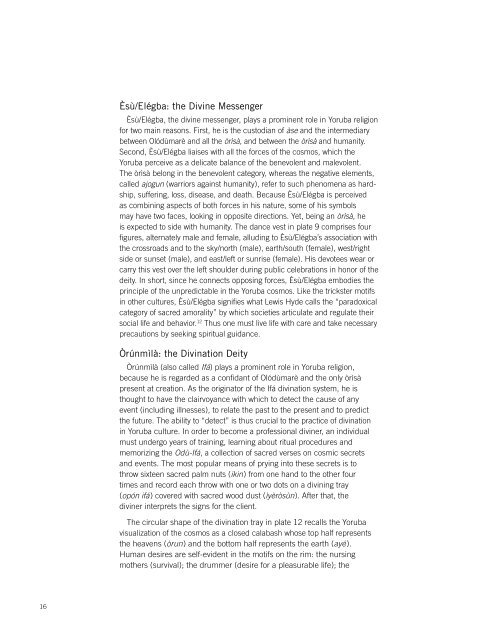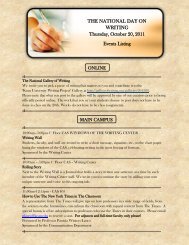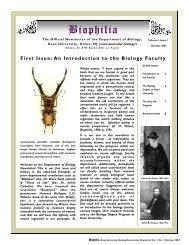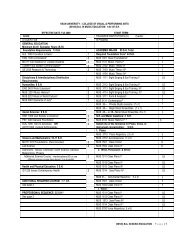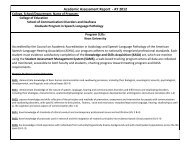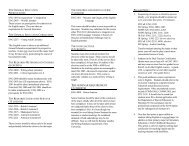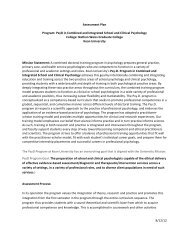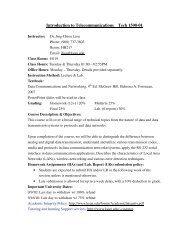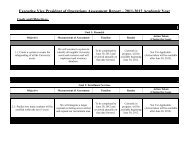Embodying the Sacred in Yoruba Art - Kean University
Embodying the Sacred in Yoruba Art - Kean University
Embodying the Sacred in Yoruba Art - Kean University
Create successful ePaper yourself
Turn your PDF publications into a flip-book with our unique Google optimized e-Paper software.
16<br />
Èsù/Elégba: <strong>the</strong> Div<strong>in</strong>e Messenger<br />
Èsù/Elégba, <strong>the</strong> div<strong>in</strong>e messenger, plays a prom<strong>in</strong>ent role <strong>in</strong> <strong>Yoruba</strong> religion<br />
for two ma<strong>in</strong> reasons. First, he is <strong>the</strong> custodian of àse and <strong>the</strong> <strong>in</strong>termediary<br />
between Olódùmarè and all <strong>the</strong> òrìsà, and between <strong>the</strong> òrìsà and humanity.<br />
Second, Èsù/Elégba liaises with all <strong>the</strong> forces of <strong>the</strong> cosmos, which <strong>the</strong><br />
<strong>Yoruba</strong> perceive as a delicate balance of <strong>the</strong> benevolent and malevolent.<br />
The òrìsà belong <strong>in</strong> <strong>the</strong> benevolent category, whereas <strong>the</strong> negative elements,<br />
called ajogun (warriors aga<strong>in</strong>st humanity), refer to such phenomena as hardship,<br />
suffer<strong>in</strong>g, loss, disease, and death. Because Èsù/Elégba is perceived<br />
as comb<strong>in</strong><strong>in</strong>g aspects of both forces <strong>in</strong> his nature, some of his symbols<br />
may have two faces, look<strong>in</strong>g <strong>in</strong> opposite directions. Yet, be<strong>in</strong>g an òrìsà, he<br />
is expected to side with humanity. The dance vest <strong>in</strong> plate 9 comprises four<br />
figures, alternately male and female, allud<strong>in</strong>g to Èsù/Elégba’s association with<br />
<strong>the</strong> crossroads and to <strong>the</strong> sky/north (male), earth/south (female), west/right<br />
side or sunset (male), and east/left or sunrise (female). His devotees wear or<br />
carry this vest over <strong>the</strong> left shoulder dur<strong>in</strong>g public celebrations <strong>in</strong> honor of <strong>the</strong><br />
deity. In short, s<strong>in</strong>ce he connects oppos<strong>in</strong>g forces, Èsù/Elégba embodies <strong>the</strong><br />
pr<strong>in</strong>ciple of <strong>the</strong> unpredictable <strong>in</strong> <strong>the</strong> <strong>Yoruba</strong> cosmos. Like <strong>the</strong> trickster motifs<br />
<strong>in</strong> o<strong>the</strong>r cultures, Èsù/Elégba signifies what Lewis Hyde calls <strong>the</strong> “paradoxical<br />
category of sacred amorality” by which societies articulate and regulate <strong>the</strong>ir<br />
social life and behavior. 12 Thus one must live life with care and take necessary<br />
precautions by seek<strong>in</strong>g spiritual guidance.<br />
Òrúnmìlà: <strong>the</strong> Div<strong>in</strong>ation Deity<br />
Òrúnmìlà (also called Ifá) plays a prom<strong>in</strong>ent role <strong>in</strong> <strong>Yoruba</strong> religion,<br />
because he is regarded as a confidant of Olódùmarè and <strong>the</strong> only òrìsà<br />
present at creation. As <strong>the</strong> orig<strong>in</strong>ator of <strong>the</strong> Ifá div<strong>in</strong>ation system, he is<br />
thought to have <strong>the</strong> clairvoyance with which to detect <strong>the</strong> cause of any<br />
event (<strong>in</strong>clud<strong>in</strong>g illnesses), to relate <strong>the</strong> past to <strong>the</strong> present and to predict<br />
<strong>the</strong> future. The ability to “detect” is thus crucial to <strong>the</strong> practice of div<strong>in</strong>ation<br />
<strong>in</strong> <strong>Yoruba</strong> culture. In order to become a professional div<strong>in</strong>er, an <strong>in</strong>dividual<br />
must undergo years of tra<strong>in</strong><strong>in</strong>g, learn<strong>in</strong>g about ritual procedures and<br />
memoriz<strong>in</strong>g <strong>the</strong> Odù-Ifá, a collection of sacred verses on cosmic secrets<br />
and events. The most popular means of pry<strong>in</strong>g <strong>in</strong>to <strong>the</strong>se secrets is to<br />
throw sixteen sacred palm nuts (ik<strong>in</strong>) from one hand to <strong>the</strong> o<strong>the</strong>r four<br />
times and record each throw with one or two dots on a div<strong>in</strong><strong>in</strong>g tray<br />
(opón ifá) covered with sacred wood dust (ìyèròsùn). After that, <strong>the</strong><br />
div<strong>in</strong>er <strong>in</strong>terprets <strong>the</strong> signs for <strong>the</strong> client.<br />
The circular shape of <strong>the</strong> div<strong>in</strong>ation tray <strong>in</strong> plate 12 recalls <strong>the</strong> <strong>Yoruba</strong><br />
visualization of <strong>the</strong> cosmos as a closed calabash whose top half represents<br />
<strong>the</strong> heavens (òrun) and <strong>the</strong> bottom half represents <strong>the</strong> earth (ayé).<br />
Human desires are self-evident <strong>in</strong> <strong>the</strong> motifs on <strong>the</strong> rim: <strong>the</strong> nurs<strong>in</strong>g<br />
mo<strong>the</strong>rs (survival); <strong>the</strong> drummer (desire for a pleasurable life); <strong>the</strong>


